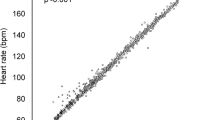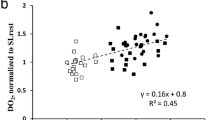Summary
Transcutaneous PO2 (PtcO2) measurements were taken daily on seven subjects during two nine day ascents of the Himalayas to an altitude of 4,579 meters. Five of the subjects lived in areas under 450 meters (Group I), while two subjects lived at an altitude of 3,100 meters (Group II). The PtcO2 values decreased with increasing altitude. The Group II subjects had PtcO2 values greater than the Group I subjects and the difference became greater with increasing altitude. The linear regression lines of PtcO2/pbO2 to PbO2 for Group I during ascent and decent were lower than the regression line for Group II (PbO2 is the barometric oxygen partial pressure). The regression line for Group I data during the second half of the trek approached the data for Group II. We conclude that acclimatization to high altitude is possibly associated with increasing peripheral tissue oxygenation as assessed by PtcO2 values.
Similar content being viewed by others
References
West JB, Lahiri S, Gill MB, Milledge JS, Pugh LGCE, Ward MN: Arterial oxygen saturation during exercise at high altitude. J Appl Physiol 17: 617–621, 1962.
Kronenberg RS, Safar P, Lee J, Wright F, Noble W, Wahrenbrocke E, Hickey R: Pulmonary artery pressure and alveolar gas exchange in man during acclimatization to 12470 feet. J Clin Invest 50: 827–857, 1971.
Samaja M, Veicsteinas A, Cerretelli P: Oxygen affinity of blood in altitude Sherpas. J Appl Physiol: Respirat Exercise Physiol 47: 337–341, 1979.
West JB: Man at extreme altitude. J Appl Physiol, 1982; 52: 1396–1399.
Lenfant C, Sullivan K: Adaptation to high altitude. N Engl J Med 284: 1298–1309, 1971.
Huch R, Huch A, Lubbers DW: Transcutaneous measurement of blood PO2 (tcPO2): Method and application in perinatal medicine. J Perinat Med 1: 183–186, 1973.
Eberhard P, Mindt W, Junn F: Continuous PO2 monitoring in the neonate by skin electrodes. Med Biol Engin 13: 436–442, 1975.
Lubbers DW: Theoretical basis of the transcutaneous blood gas measurements. Crit Care Med 9: 721–733, 1981.
Van Duzee BF: Thermal analysis of human stratum corneum. J Invest Derm 65: 404–408, 1975.
Huch R, Huch A, Albani M, Lubbers DW: Transcutaneous PO2 monitoring in routine managenent of infants and children with cardiorespiratory problems. Pediatrics 57: 681–688, 1976.
Rowe MI, Weinberg G: Transcutaneous monitoring in shock and resuscitation. J Ped Surg 14: 773–778, 1979.
Versmold HT, Linderkamp O, Holzman M: Transcutaneous monitoring of PO2 in newborn infants: Where are the limits? Influence of blood pressure, blood volume, blood flow, viscosity and acid base state. Birth Defects: Original Article Series XV: 286–294, 1979.
Tremper KK, Shoemaker WC: Transcutaneous oxygen monitoring of critically ill adults with and without low flow shock. Crit Care Med 9: 706–709, 1981.
Jaeger J, Sylvester J, Cymerman A, Berberich JJ, Dennisten JC, Maher JT: Ventilation perfusion relationship during high altitude adaptation. J Apply Physiol 26: 77–81, 1969.
Cerretelli P: Limiting factors to oxygen transport on Mount Everest. J Appl Physiol 40: 658–667, 1976.
Humpeler E, Inama K, Deetjen D: Improvement of tissue oxygenation during a 20 day stay at moderate altitude in connection with mild exercise. Klin Wochenschr 57: 267–272, 1979.
Hebbel R, Eaton J, Kronenberg R, et al.: Human Ilamas: adaptation to altitude in subjects with high hemoglobin oxygen affinity. J Clin Invest 62: 593–600, 1978.
Eaton JW, Skelton TD, Berger E: Survival at extreme altitude: Protective effect of increased hemoglobin-oxygen affinity. Science 183: 734–744, 1978.
Hebbel R, Eaton J, Bargar E, et al: Hemoglobin oxygen affinity and adaptation to altitude: Guidance for pre-adaptation to altitude in humans with left-shifted oxyhemoglobin dissociation curves. Trans Assoc Am Physicians 91: 212–219, 1978.
Tremper KK, Waxman KS, Bowman R, Shoemaker WC: Continuous oxygen monitoring during respiratory failure, cardiac decompensation. cardiac arrest and CPR. Crit Care Med 8: 377–381, 1980.
Author information
Authors and Affiliations
Rights and permissions
About this article
Cite this article
Hufstedler, S.M., Tremper, K.K., Hufstedler, S.M. et al. Transcutaneous PO2 monitoring during a Himalayan ascent. J Clin Monit Comput 2, 77–80 (1985). https://doi.org/10.1007/BF02916235
Issue Date:
DOI: https://doi.org/10.1007/BF02916235




